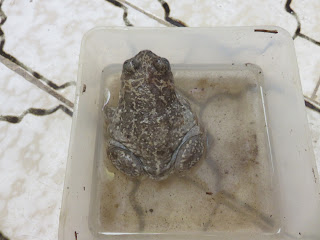A Near Threatened Species
Western Spadefoot Toad (Photo: Steve Andrews)
The Western Spadefoot or Iberian Spadefoot (Pelobates cultripes) is an endangered species of amphibian. In fact its IUCN Red List Conservation Status is Near Threatened, so I was really surprised to find one living in the front garden of the house in Portugal where I rent the ground floor. One of my pet cats was digging, and I thought she was about to go to the toilet, but instead, and suddenly, she had grabbed something and tossed it onto the ground. I could see it was a large frog or toad and immediately went to the rescue. I was amazed to find that it was a female Iberian Spadefoot. I have only seen these in photos in books and on sites on the Internet, and knowing how rare they are now, the last place I thought I would see one was caught by my cat in the garden of where I live!
Caught by a Cat
Clearly where the toad had been living, even though it was buried in the sandy soil, was not a safe place to be. My cat could hear it or smell it, and could catch it again if I put it back, I could end up harming or killing it by accident if I was digging, or the toad could get run over on the road, just yards from where it had been buried. So I resolved to move it to some local woodland just five minutes away.
Woodlands on sand (Photo: Steve Andrews)
There is an area where there is a stream and marshy section that has temporary pools after autumn and winter rains, though they are already drying up now. I took it there, thinking it would be safer. I know there are Iberian Water Frogs there, though haven’t seen any this year. I think last year’s terrible drought affected them badly in many places like this that dried out completely. Fortunately, this winter and early spring brought plenty of very welcome heavy rains. These local woodlands near where I live are very interesting because the cork oak and pine trees are mainly growing in sand. Sand martins nest in holes in the sand banks.
Pelobates cultripes tadpole about to become a toadlet (Photo: Franco Andreone)
This amphibian gets its name from its habit of digging burrows. It does this with the aid of its back feet that are specially adapted for the purpose with a black hardened projection like a spade on each one. This behaviour works well in the sandy soil so much of Portugal has, and I would never have known about the one in the garden here if my cat hadn’t detected it and dug it up. She used to be a feral cat so is excellent at hunting, and can even find toads hidden underground.
My Calico Cat (Photo: Steve Andrews)





No comments:
Post a Comment